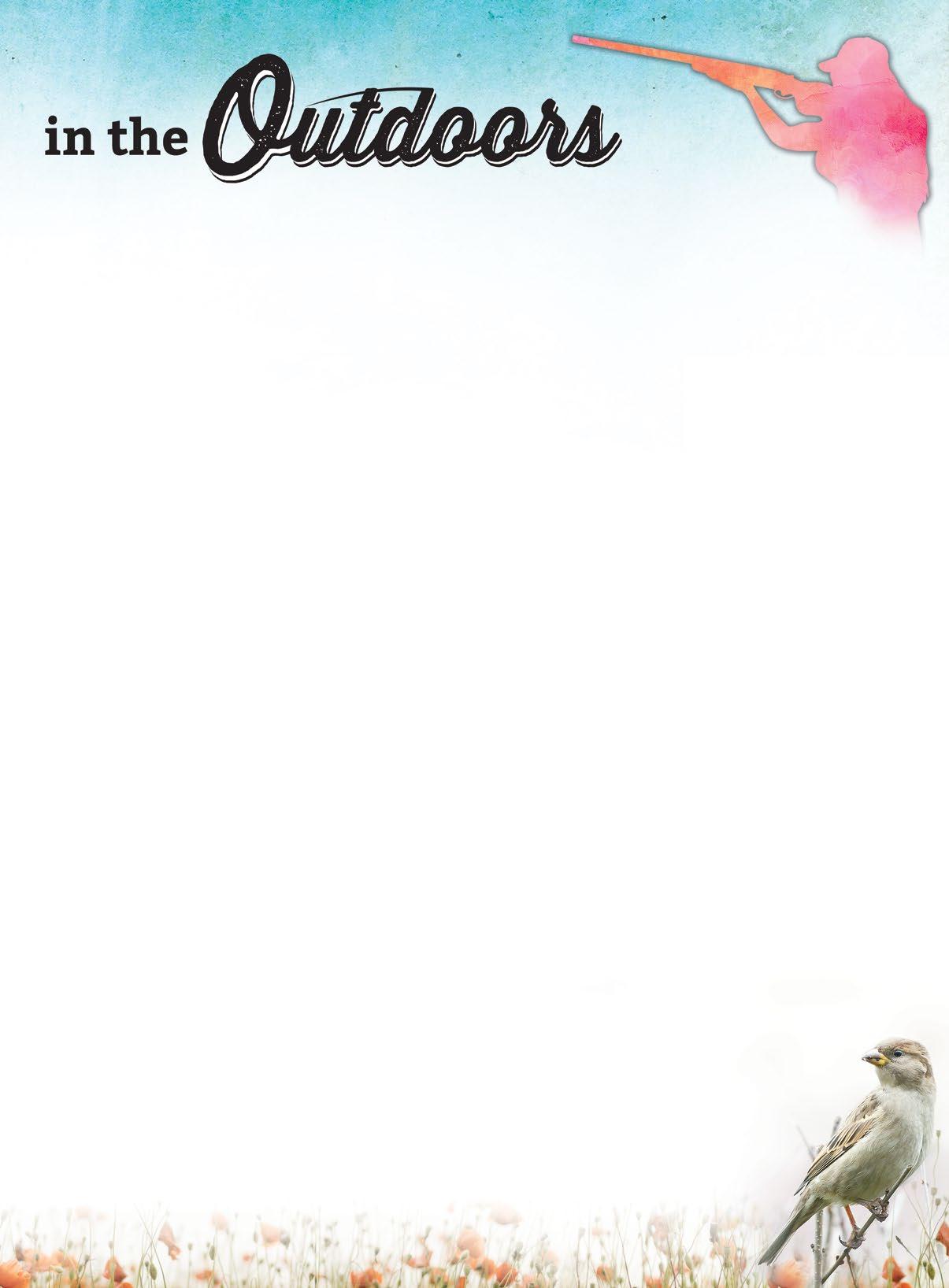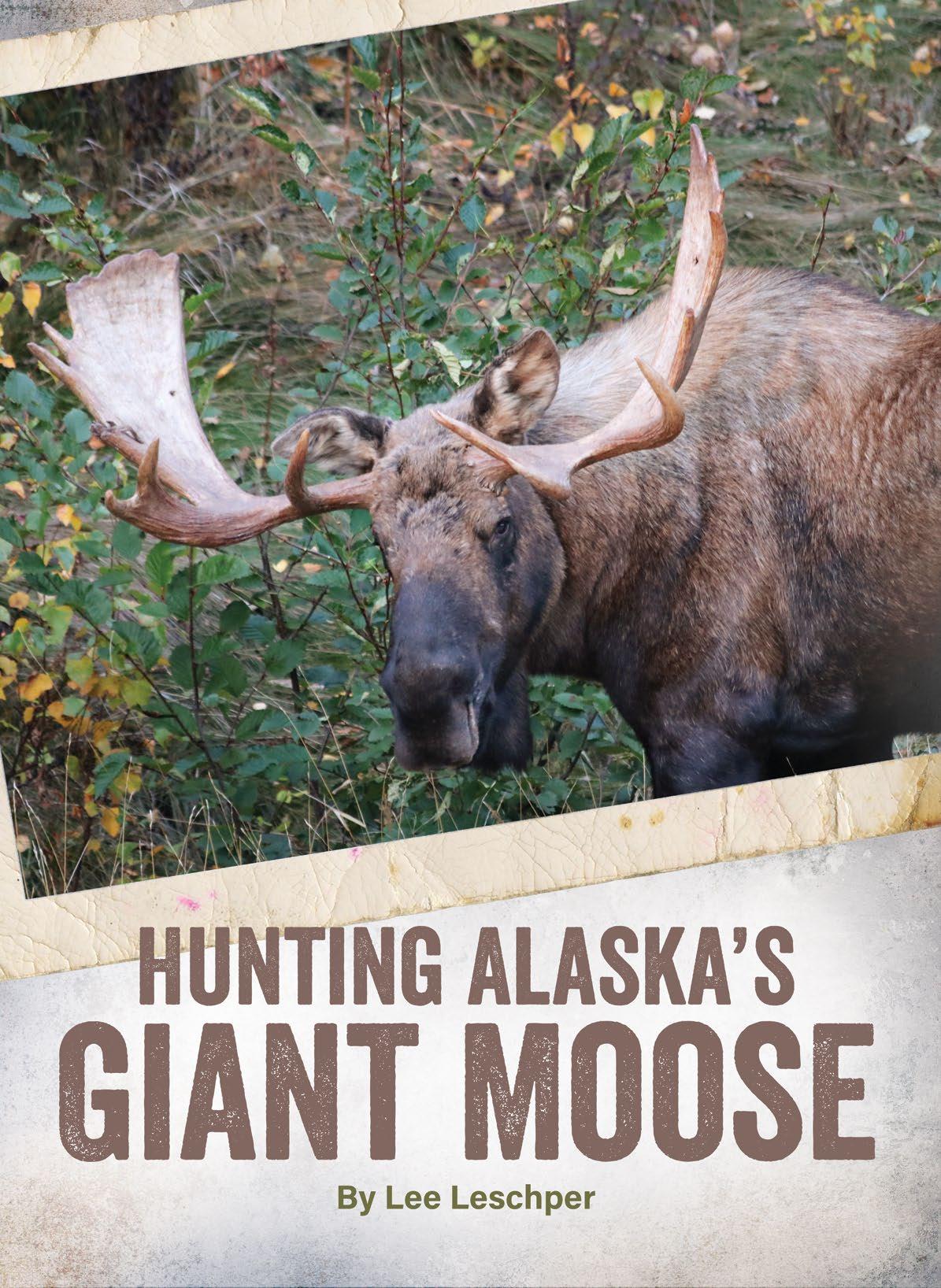
19 minute read
Hunting Alaska’s Giant Moose
He might look big, but this bull is not legal in most of Alaska because he's neither 50 inches wide nor has the required three brow tines on either antler.
Waiting patiently and calling a lot are keys to most successful Alaska moose hunts. Here, Denny Wood uses a fiberglass funnel to magnify the cow calls he's making.
For once, I had absolutely no interest in this bull moose. I had been following up on a cow moose I intended to shoot for my winter’s meat when this smallish bull stepped out into the narrow clearing along a powerline right of way.
The tag in my pocket was for a cow moose. And a perfectly huge mature cow had moments before been well within range, when the bull’s noisy approach spooked her back into the willows. And while I also had the option of taking a bull with antlers at least 50 inches wide, this “little” guy was not more than 3 feet wide and did not qualify. He was still an awesome sight of jet black with amber antlers against a backdrop of golden birch trees.
I casually snapped a few photos of the approaching bull, pleased to have such a close encounter, but disgusted he had scared off 500 pounds of prime cow meat. Then I noticed he was coming on a beeline, either mistaking me for the cow or for a rival.
At 30 feet, legal or not, he was about to get a snootful of .300 Win. Mag. I yelled, and he sidled sideways, still shaking his head, but finally convinced it was time to move on. Just another day moose hunting in Alaska.
When a 7-foot-tall, 1,200-pound moose attacks, you move fast. Moose have killed numerous people in Alaska, including inside the Anchorage city limits—both rutting bulls and especially protective cows with new-born calves. Any Alaskan will tell you a mama moose can be more dangerous than a grizzly under most circumstances.
I’m looking ahead eagerly to another September chasing these giant Alaska deer. Moose season is the closest thing we have to a state holiday in Alaska. Do not come looking for an Alaskan in September, unless you are prepared to help pack out moose quarters! Alaska moose season runs Sept. 1-25 and success in that brief window means a winter of steaks and stew, while failure means looking for something else for dinner.
Whether you are looking for meat or a true trophy of a lifetime, today is still a great time to hunt moose in Alaska. Most guides were not able to operate at full capacity with COVID restrictions on travel in 2020 and so there was less hunting pressure. There are still true giant moose killed in Alaska every year, with at least a few pushing 70 inches of spread. Just a few years ago, an Alaska guide killed a bull that’s now number four all-time in the Boone and Crockett Record Book, a bull with a spread of more than 80 inches! If I were coming to Alaska for my first and maybe only moose hunt, I would either invest in a premium guide with proven moose country and better references, or I’d plan for a couple of years of drop-off hunts, knowing the odds of success are lower. You legally do not have to hire a guide to hunt moose in Alaska, as non-residents must do to hunt brown bears or sheep. But it sure helps. Having somebody who has scouted the country, has the right gear, and can get you safely in and out with your game is priceless. However, the going rate for top shelf moose hunts today is about $27,500. The other very reasonable option is having a good transporter deliver you into good country, where you hunt on your own. You have to camp, cook your own meals, scout, and hunt as you like, and also have to get your game back to the landing strip or riverbank. Expect to spend anywhere from $1,500 to $4,000 for a drop-off hunt by bush plane or boat. I like this kind of hunt. Moose are a challenge, but the good news is moose hunting is in essence a lazy man’s sport. Getting there is hard, usually by float plane or boat. Getting home with a quarter ton of meat is tougher, but the hunt itself is a waiting game of glassing and calling. The biggest mistake for new moose hunters is trying to move too far, cover too much ground, and in the process spooking the animal you want. With all those millions of acres of Alaska to hunt, it is hard to slow down. But the penalty for impatience is busting the animal you have come so far to hunt, and when a moose spooks, it doesn’t stop running until it finds a new zip code.
Here's a bull moose few hunters would pass up—close to 60 inches wide and with a forest of antler points.
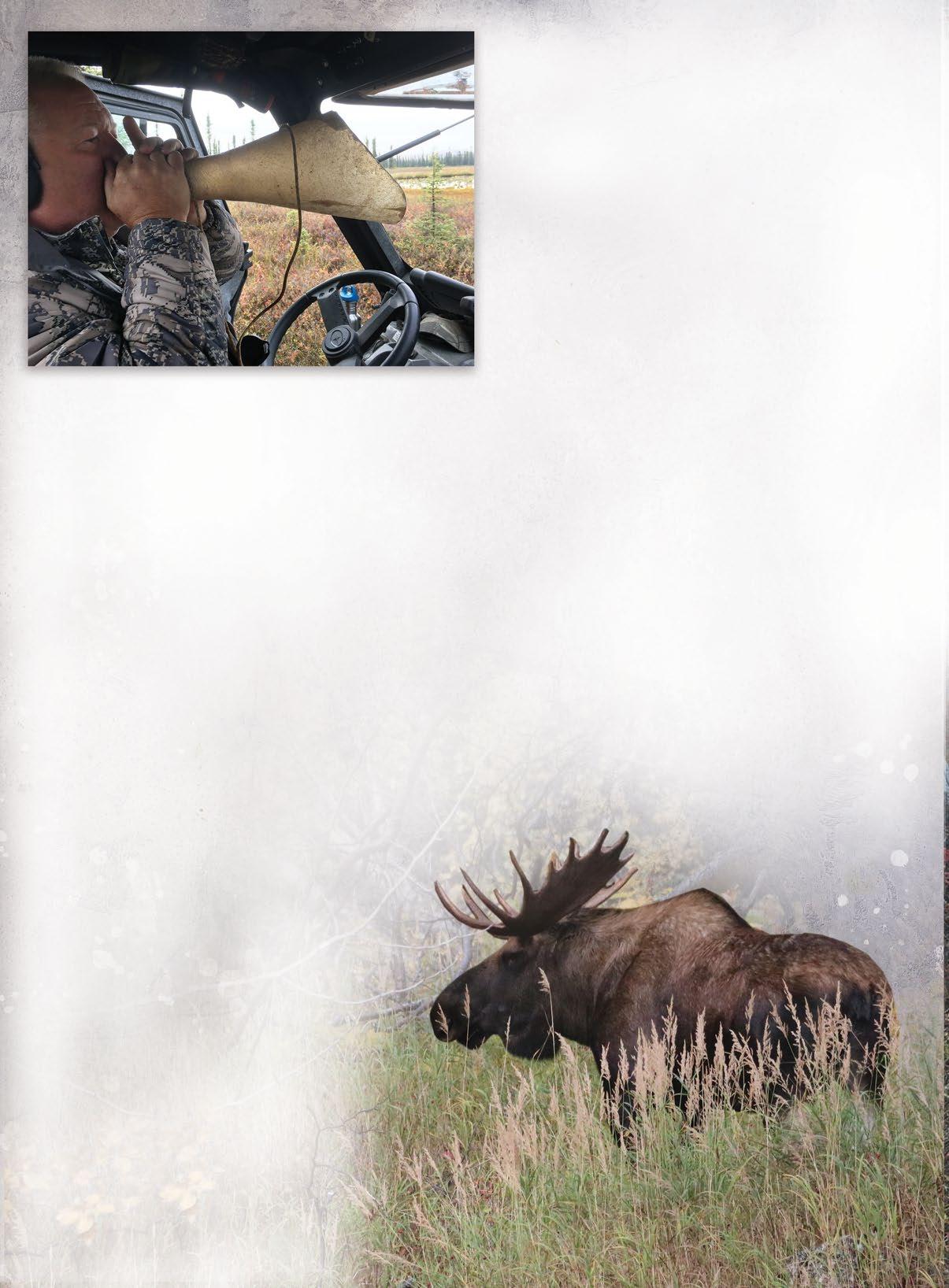
Get into good moose country to a good vantage point, get comfortable and start looking. And waiting. And calling.
Anybody, regardless of physical ability, has a chance to kill a moose, as long as you can get into moose country. You do not have to be able to run a marathon or lift a 100-pound pack to be success. That lifting will come later when Bullwinkle is on the ground. It is a perfect old man’s game.
Some of my friends prefer to use a treestand as a viewing platform and it works very well. Even a few feet of elevation help get you above all that screening brush. A dear friend in Southeast Alaska has killed his moose out of the same tree near Glacier Bay National Park for many years.
For some reason, I find I am most smitten with any game animal that responds to calling, be it ducks, turkey gobblers, whitetail bucks, or moose. Imagine calling to a 1,200-pound turkey gobbler and you are in the hunt. There are two types of calls: the grunt of an amorous bull, to bring out his competitive nature, and the long plaintive moan of a lonely cow. The cow call is best in most situations. If there is a wrong way to use a cow call, I have never heard it, and if the bull is in the mood, it will not matter.
Whacking brush with a boat paddle or, ideally, an old, dried moose shoulder blade, adds drama to your calls and can sometimes get a hung-up bull to come in. If you are near water, pouring a long stream of water from shoulder high into a lake to imitate the sound of a urinating cow can also work.
A lovesick bull moose will come several miles to a call. Sometimes there is nothing subtle about their approach, with eyes wide, swaying head and antlers side to side, often sidling sideways when they get close. It is one of the great experiences in North American hunting. The superpower of Alaska moose is they can be invisible, especially for such a huge animal.
I live with moose every day and many times have stepped outside and then turned back to walk inside my house, only to find a moose just feet away, that I had just walked past. Like other deer, they are most active early and late in the day and will bed down in thick brush during midday. And vanish. You will glass a broad valley for hours or days, see nothing, and then suddenly a bull appears as if from thin air.
Moose are a combination of black and dark brown hide that is great camouflage especially in low light. When glassing, watch for any white or light tan, which will be sunlight reflecting off those wide antler paddles. In a perfect world, a bull comes in just like that old gobbler, to point blank range. But do not count on it. Be ready, with a stable rest, to shoot at the first reasonable range. If he is open enough that you might be able to make a quick follow up shot, so much the better. Don’t hesitate to put a second bullet into a bull moose!
Rifles for moose vary, and a good .270 or .30-06 with good heavy bullet will take any moose. However, if you are shopping for a moose rifle, you would do well to choose a .300 or .338 Win. Mag. if you can take the recoil. Such calibers give you the advantage of having a rifle capable of staving off a grizzly bent on claiming your dead moose.
I shoot a .300 Win. Mag. that is accurate, and capable of dropping a moose at some distance. If a grizzly shows up, it will take care of him, too.
Giant bulls remain in Alaska, like this huge moose Jim McCormick shot several years ago, after watching the same alder thicket for several days.
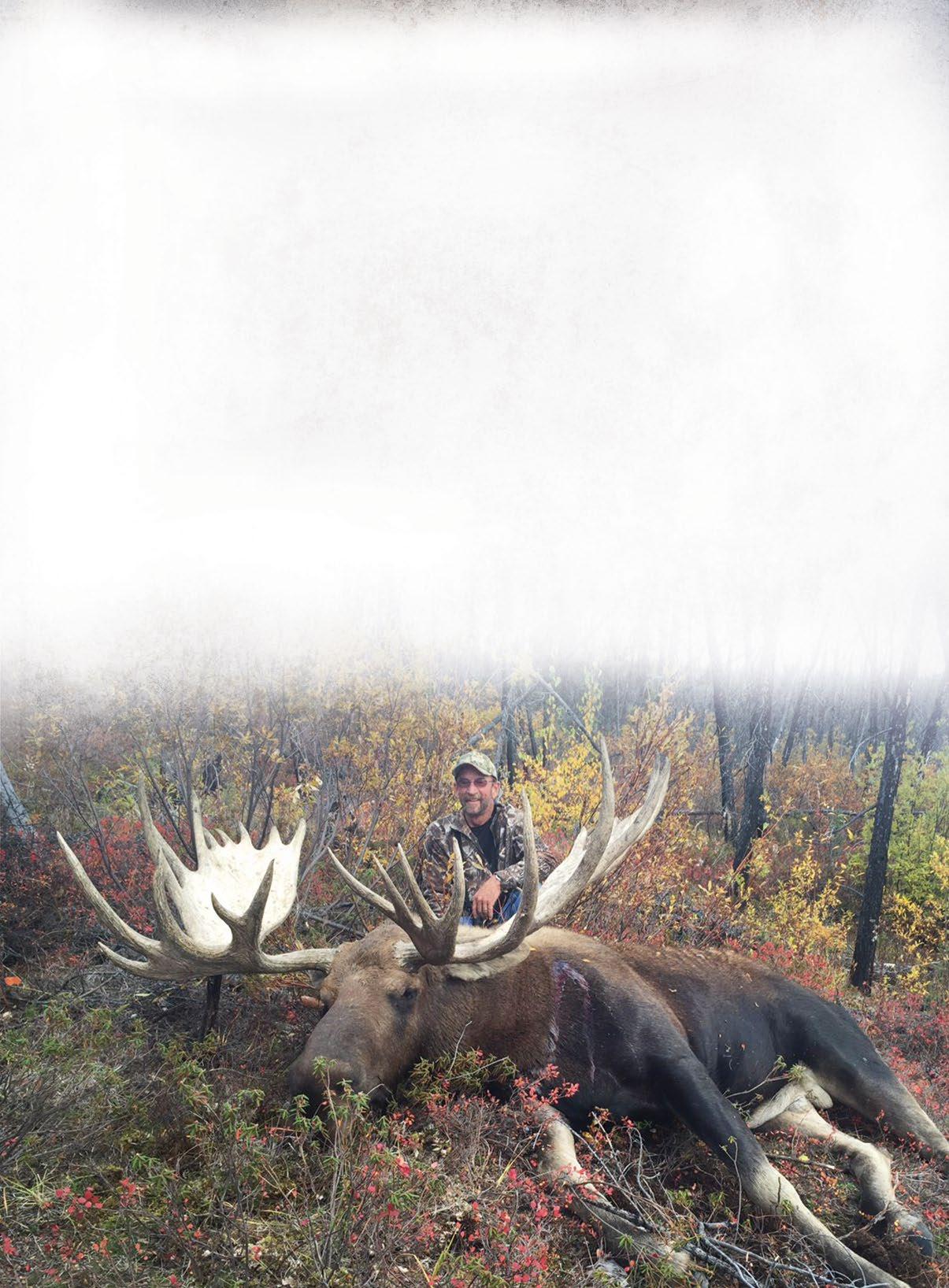
Brandon with the large feral hog sow mentioned in the opening paragraph. One well-placed arrow on the quartering away hog at 24 yards produced a quick kill.
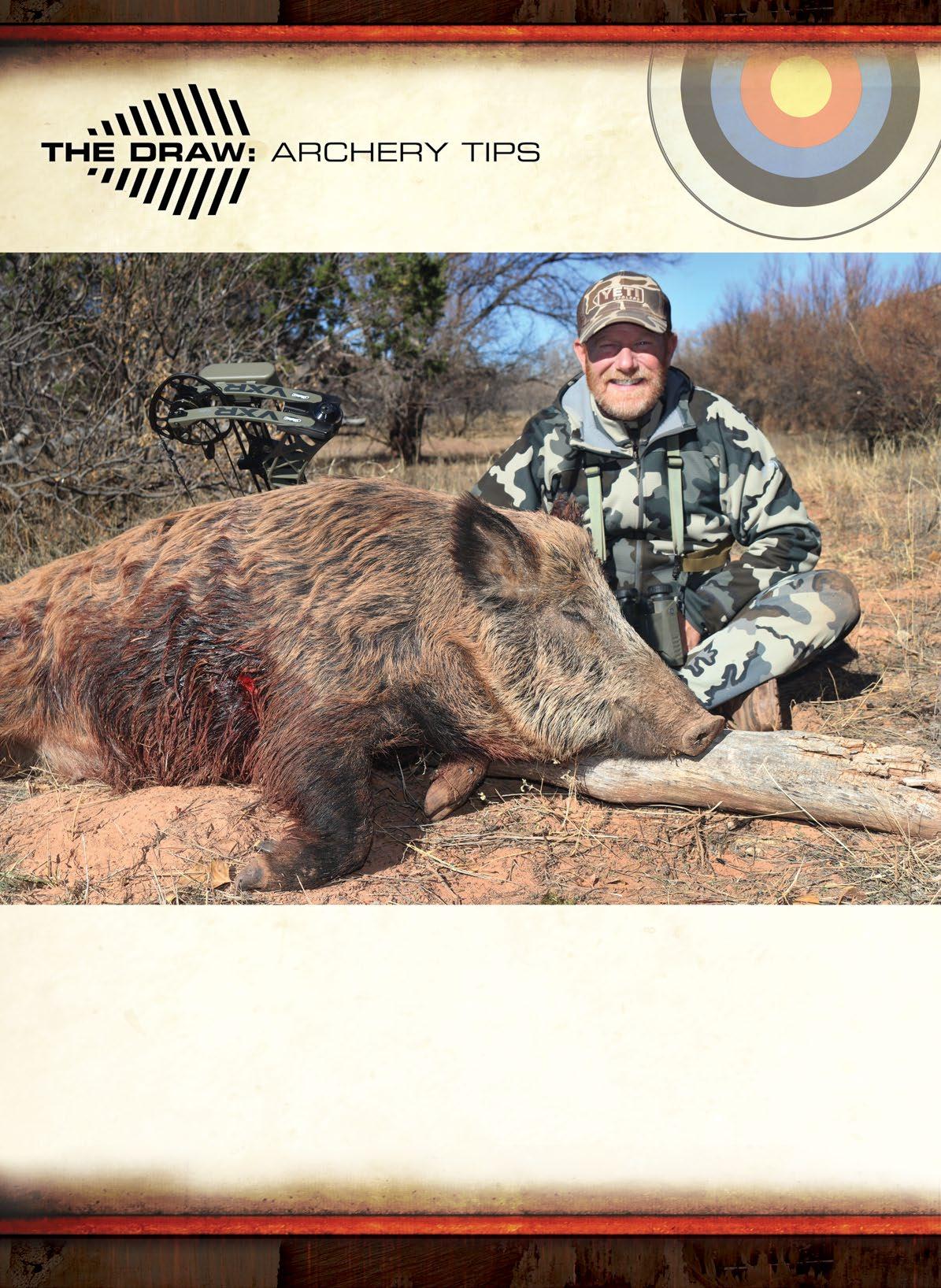
BULL’S-EYE BOWHUNTING
Insist on perfect arrows for better shots
By Brandon Ray
The herd of hogs appeared from the creek at sunset. Like a swarm of ants at a picnic, the noisy mob vacuumed up corn kernels. From a short tripod stand buried in a cedar tree, I waited for the biggest in the herd to turn broadside. With daylight fading, the jumbo-sized sow turned slightly quartering away at 24 yards.
The bowstring touched the tip of my nose, my eye was in the peep and the bright green pin was solid behind the hog’s massive shoulder. At the shot, my 450-grain arrow led by a 4-blade Wasp Dart broadhead passed through the big hog’s chest taking out both lungs. A good blood trail by the beam of my headlamp led me to the grizzled-looking pig less than 100 yards away. Lots of practice and top-notch arrows made the shot seem easy.
PERFECT ARROWS
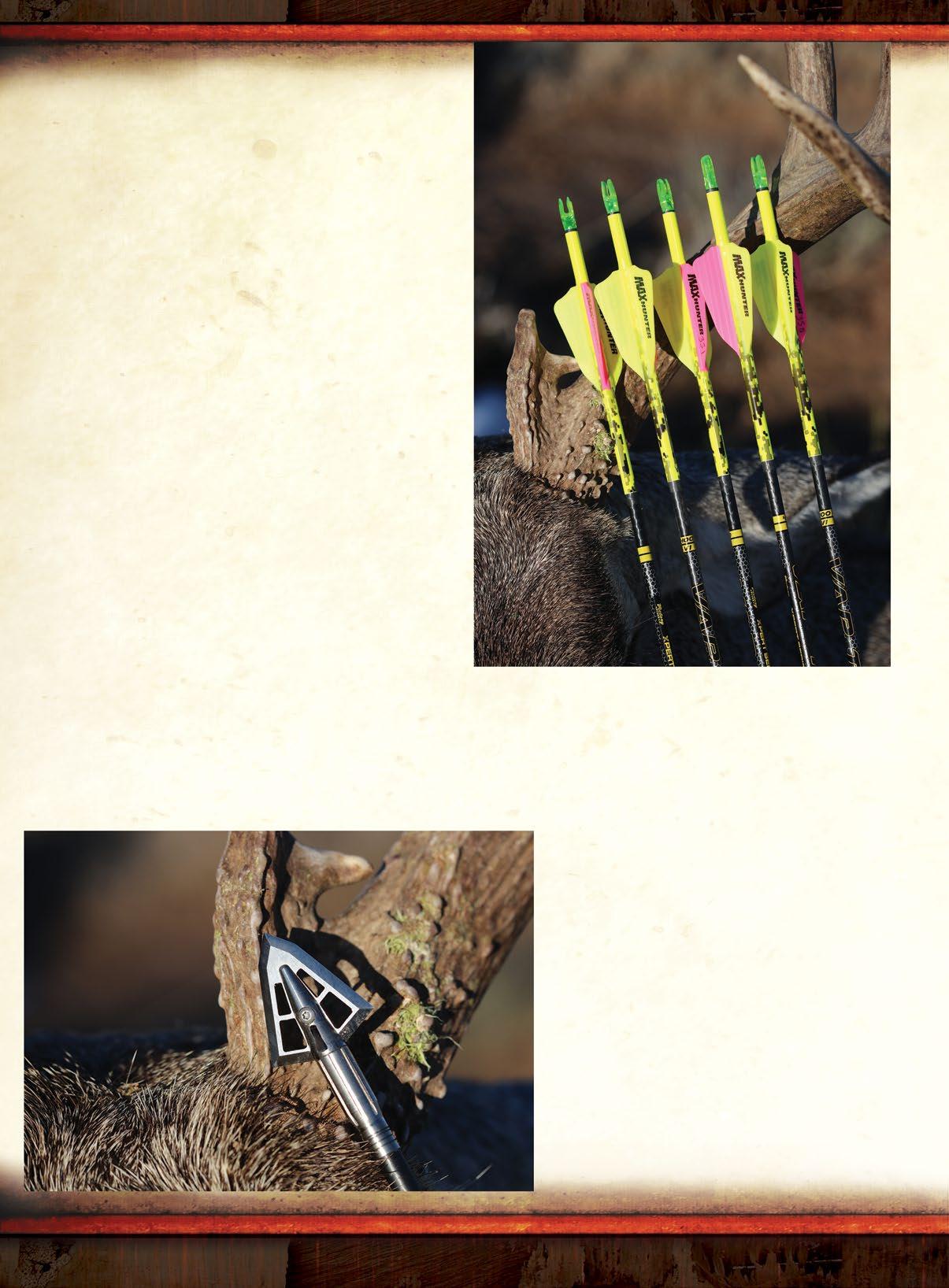
I drive a truck with 200,000 miles on it. My sneakers are six years old, and my socks have holes in them, but my arrows are the best you can buy. Why? The arrow and broadhead are the two most important parts of the bowhunter’s kit. Skimp on a cheap stabilizer, but don’t cut corners on the arrow or broadhead.
Start with shafts of the highest straightness tolerance available. Top brands like Easton, Gold Tip and Victory offer their best in a .001" tolerance. It’s worth it. Next, consider skinny shafts. All three top arrow makers offer “skinny” shafts.
The benefits of a 4mm shaft are better penetration compared to a standard shaft diameter and less drift when shooting in a crosswind. Top picks include the Victory VAP, Victory VAP TKO, Easton 4mm FMJ, Easton 4mm Axis Long Range and the Gold Tip Airstrike. I’ve hunted with skinny shafts since 2013. No doubt I see improved penetration from my modest poundage setups, usually 60 pounds of draw weight, on deer-sized game. For open country game like mule deer and antelope, the skinny shafts drift less so long-range accuracy improves.
I fletch all my own arrows. I use a Bitzenberger jig with a slight offset to each vane. I prefer AAE Max Hunter vanes attached with AAE Max Bond glue. Add a drop of glue on the tip and tail end of each vane. I’ve had good luck with a three-fletch configuration, but I know other expert archers who prefer fourfletch for a more forgiving fletch orientation with broadheads. When I cut the shafts, I use a G5 Arrow Squaring Device to ensure the insert mounts square. I use AAE Max Impact to install inserts. Look for nocks that attach snug to the string, but not too tight. Consider aluminum or pin nocks. Right now, my go-to setup includes skinny shafts with an Easton G nock. The G nock snaps the string with just enough pressure, not too tight and not too loose. On the front of the shaft, I prefer heavy, rugged stainless steel, brass or titanium insert/outserts. I’ve tried the lighter aluminum inserts, but over time, they take a hit from either another arrow in a target or some other hard contact and they take a bend. They don’t spin true after prolonged shooting. The heavier steel or titanium insert/outserts stay true longer. Most of these heavier options will weigh 50 to 100 grains. I like that added weight on the front of my arrow. My current rig includes a 95-grain insert/outsert and a 100-grain broadhead. That higher front-of-center (FOC) groups well with broadheads at long distances and improves penetration on animals.
A close-up of a 100-grain, 4-blade, Iron Will broadhead. Notice the stout 95-grain stainless steel insert/outsert for added strength and front-of-center weight. A closer look at the author’s most recent deer arrows. These were fletched with AAE Max Hunter vanes.
Arrow weight is a common topic for debate. I’ve tried very light, and I’ve tried very heavy. For the deer-sized animals most of us hunt, big game that weighs 300 pounds or less, I believe a mid-weight shaft is the best choice. Something heavier than 400 grains, but lighter than 500 grains. I’m talking game like pronghorn, whitetails, mule deer, hogs and black bear. My current deer arrows weigh 450 grains. That’s the finished arrow with the point. It’s enough weight for con-
sistent penetration, but light enough for decent speed. Lighter than 400 grains and I’ve run into deflection issues on bone or quartering angles. Heavy arrows, 500-600 grains, will penetrate like a train through smoke, but the arching trajectory on longer shots can mean large pin gaps and slow arrow speed.
When my arrows are finished, I spin each one on a set of rollers with the point touching a dot on the wall. Anything less than a perfect, true spinning arrow gets set to the side for further evaluation. Next, each finished arrow is weighed on a grain scale. (You can buy a compact grain scale at lancasterarchery.com for under $40.) I use a black Sharpie marker to write the weight on one of the vanes. Ideally, each finished arrow will weigh exactly the same, but a variance of a few grains of arrow weight does not seem to affect my accuracy at my skill level. Still, I keep all my hunt-ready arrows to a weight tolerance of no more than five grains difference. Last year’s batch weighed 445-450 grains.
When selecting shaft size, consider the stiffer of the two options on the arrow chart. For example, if the chart says your draw weight and arrow length hits between a 400 and a 340 spine, go with the stiffer 340 spine. The stiffer shaft will control a broadhead better than the weaker shaft.
Broadhead choice stirs up debate among every bowhunter. Mechanical or fixed-blade? Two, three or four blades? An 85-, 100-, 125- or 150-grain weight? I’ve seen all these options work, but I’ve also witnessed some equipment failures. I will share my personal choice after 35-plus years of bowhunting.
I prefer fixed-blade heads for their durability and consistent penetration on game from my modest draw-weight bows. The argument that fixed-blade heads don’t fly good really doesn’t hold water these days. I shoot fist-sized groups out to 60 yards with fixed-blade broadheads. It starts with a top-notch arrow and components and a well-tuned bow. I prefer 4-blade heads for more cutting area and better blood trails. The more compact ferrule design of modern broadheads also helps with better accuracy. A few current favorites include the Slick Trick Standard, Wasp Dart, Wac Em, Grim Reaper Micro Hades Pro, Solid Legend and Iron Will. Top picks for a fixed 3-blade would include the Wasp Drone, G5 Striker, G5 Montec, NAP Thunderhead and the Muzzy Trocar. Broadheads should be scary-sharp and consistent in weight from one to the next. I weigh every broadhead I shoot on a grain scale. Very few weigh exactly as advertised and some vary widely. Next, I stretch a rubber band tight between two fingers then slide the broadhead across the band to check for sharpness. The rubber band should cut with ease. When I have a perfect arrow matched with a scary-sharp, true-spinning broadhead, I add plumber’s Teflon tape to the threads, then tighten it down with a broadhead wrench. A small dab of oil keeps my blades sharp and rust-free in my quiver.
My old truck needs a tune-up. I also need new socks and sneakers, but my arrows are perfect. If you are serious about bowhunting, don’t settle for anything less than great arrows.
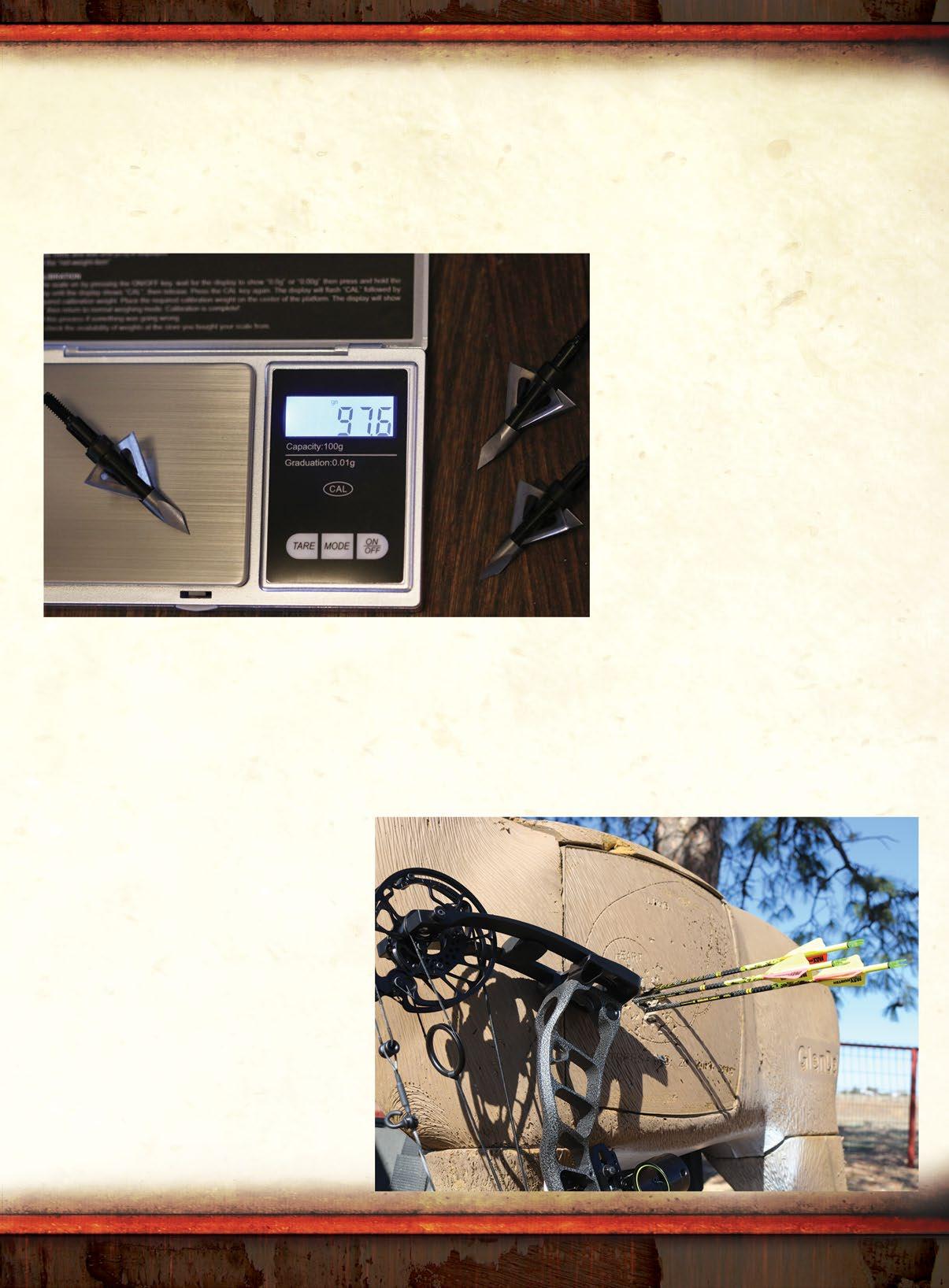
This broadhead weighed 97.6 grains. It’s OK if the weight is not exactly 100 grains as long as the weight of each head is consistent from one package to the next. Very few broadheads weigh exactly as advertised, according to Brandon. A tight wad of arrows in the target at 20 yards. Insisting on high-quality, consistent arrows will lead to better shots on game.
DIVA WOW: Judy Rhodes
By Sheryl Smith-Rodgers
Judy Rhodes loves telling success stories about the members of DIVA WOW (Women Outdoors Worldwide), a non-profit women-only outdoor organization that she founded 22 years ago. And, trust me, she has loads to share. Like the one about the Dallas woman who’d never handled a gun before. Five years ago, she attended a DIVA WOW Shotgun Showcase Clinic and learned how to shoot a shotgun. Now she’s an All-American trap shooter.
Oh, then there’s the lady in Florida who was anti-guns before she met Judy. She came on board as a writer hired to cover a DIVA hunt. In the field, the women’s camaraderie amazed her so much that she joined the organization. Now she hunts, trains and shows hunting dogs.
Here’s a good one. A wife in Maryland had never been around firearms either. She joined DIVA WOW and got hooked on shooting handguns at a weekly handgun league. Under her guidance, so did her husband, another newbie to guns. After he shot his first elk, she gave him his first rifle as a Christmas present. Now their home features a new room they had built just to display their trophies.
One after another, Judy’s stories convey the impact that DIVA WOW has made on countless lives.
“Our mission is to introduce women to the great outdoors,” Judy told me over the phone from her Dallas home. “When I first started, women didn’t have a place in the outdoors. They also didn’t have women-friendly teachers or mentors. They just
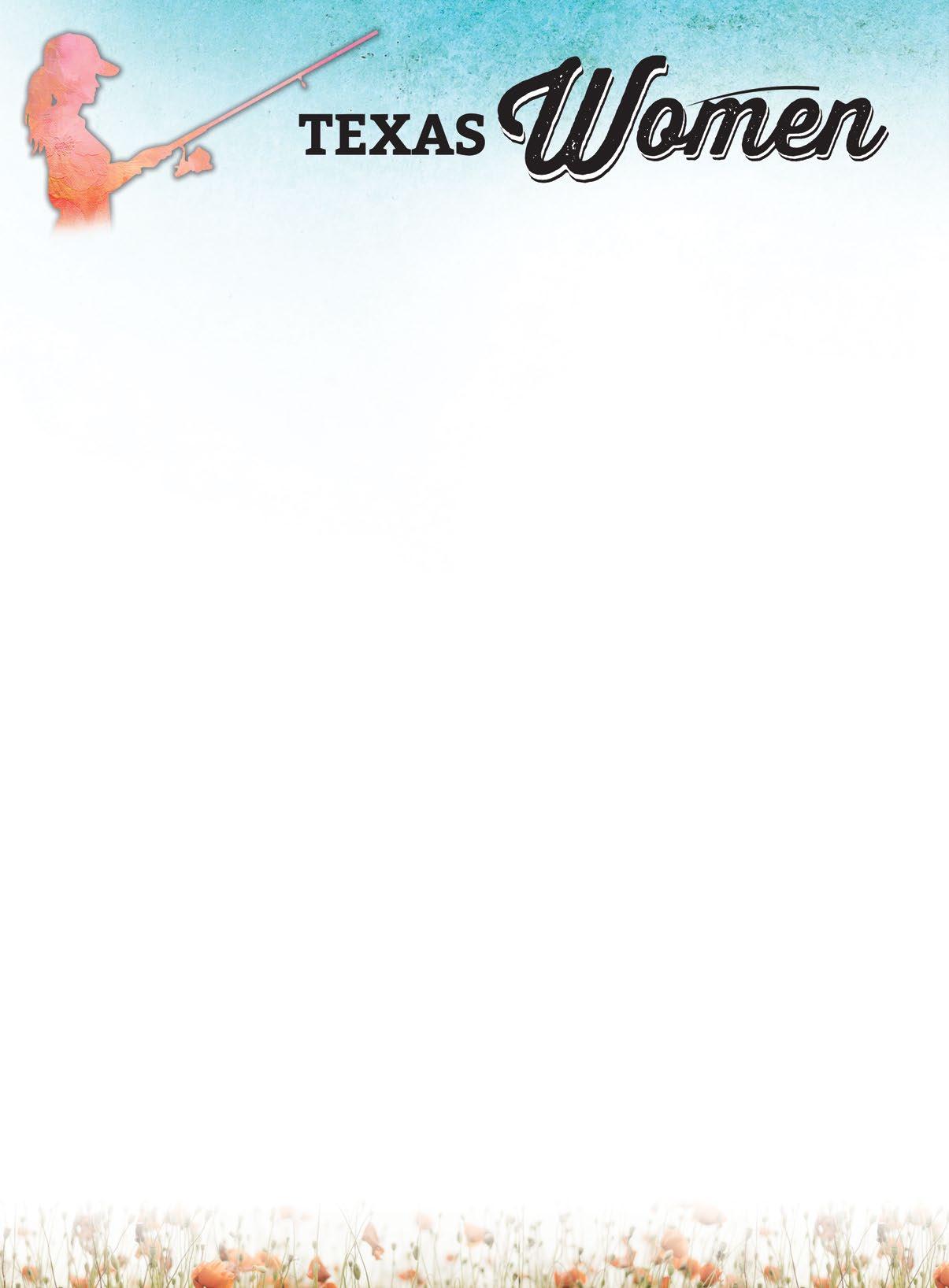
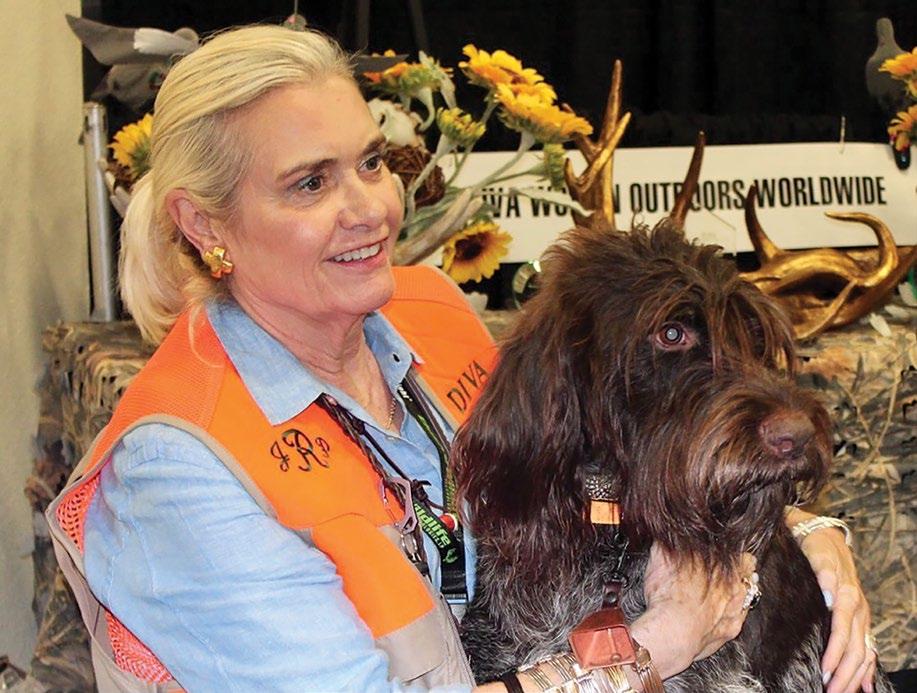
Judy Rhodes is a native Texan who has shot guns since the age of four. She founded the DIVA WOW (Women Outdoors Worldwide) women-only outdoor organization 22 years ago. Judy says that DIVAs have a zest for life. “We’re not wall flowers. We’re alpha women. We’re fun and sincere. We’re not fake women, because you can’t fake love for the outdoors.”
Judy, at left in this shotgunning quartet, says DIVA WOW has something for every woman who wants to enjoy the outdoors, including bird hunting and fishing trips. Judy was recently scheduling her ninth Grand Slam turkey-hunting excursion, which included road trips to Florida, Texas and Colorado to hunt four wild-turkey subspecies.
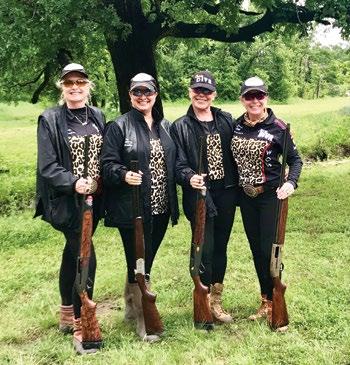
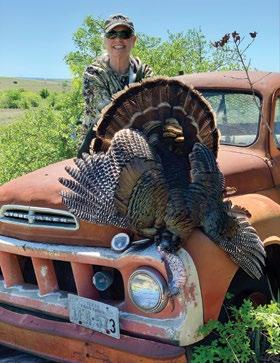
went along with their husbands.”
Judy, a native Texan who’s shot guns since age four, chuckled. “Now men tell me, ‘Thanks for introducing my wife to shooting. It’s costing me double!’”
Or more. That’s because the outdoor industry caters to women consumers more now than ever before. “Men tend to keep their same shooting bag for years,” Judy said. “We women ask, ‘How many colors does that come in?’ We need different bags for shotguns, rifles, handguns and hunting. We don’t stick with just one item, and the industry finally picked up on that.”
“We women need guns, clothes and boots that fit our bodies,” she continued. “When I joined my husband on hunts, I was thankful that I could wear his hand-me-downs. Today the outdoor industry recognizes women as consumers. Now we can shop in a complete department of women’s clothing, guns, boots and accessories.” But it’s not all about accessories.
“DIVA WOW has something for everybody who wants to be a part of the outdoors,” Judy said. “However, not everyone wants to learn how to shoot a gun. So we also do fly fishing, spin casting and kayaking trips. We’ve even gone on frog hunts, and we go on an annual road trip. I’ve taken lots of women on their first African safari.”
Safaris didn’t happen in 2020, though. Thanks to the pandemic, Judy—a globetrotter who’s gone on 24 African safaris and normally hunts and fishes 250 days a year—had to nix more than 20 hunts. DIVA WOW clinics and other events got cancelled, too.
But not even a worldwide pandemic can slow down Judy, who receives 450 e-mails daily.
When we talked, she was in the midst of prepping for a DIVA WOW spring 2021 clinic in Dallas. She was also scheduling her ninth Grand Slam, which included April road trips to Florida, Texas and Colorado to hunt four wild turkey subspecies: Eastern, Osceola, Rio Grande and Merriam’s. Along the way, she planned to visit other DIVAS, many of whom she knows personally around the world.
Making connections and lasting friendships are part of the DIVA WOW experience.
“We have DIVAS from 27 countries and all 50 states,” she said. “About 85 percent of us are life members, and we retain 88 percent of our membership on an annual basis. Our youngest member ever was one hour old. Now she’s 12. One of our oldest members is my mother. She’s 95.”
“We’re not for everybody, though,” Judy continued. “We DIVAs have a zest for life. We’re not wall flowers. We’re alpha women. We’re fun and sincere. We’re not fake women because you can’t fake love for the outdoors. We teach conservation. Whenever we host DIVA-sponsored hunts, women can’t go unless they have a hunter’s safety certificate. We’re also an outdoor partner with Texas Parks and Wildlife Department. We were the first to develop a Hunting 101 program.”
Oh, just one more story. The weekend before Judy and I talked, a friend introduced her to his sweetheart at the Dallas Gun Club. He’d just gifted her with a 28-gauge shotgun. But the woman was uncomfortable about handling the firearm.
“I asked her why,” Judy said. “She said she was afraid someone would laugh at her. Right away, I told her, ‘Then you have the wrong friends! You need to join DIVA WOW, and we’ll help you to be successful in shooting your new gun. We’re your tribe.’”
“I just love it when I hear women say they’ve met their new tribe,” she added. “That’s DIVA WOW!”
For more info, visit www. divawow.org.
